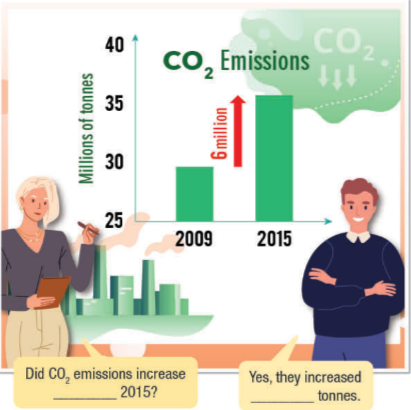Tiếng Anh 11 Unit 4 Lesson 1Let's Talk! In pairs: Which environmental problem does this picture show? What are some things humans do to cause this environmental problem? New Words a. Match the underlined words to the definitions. Listen and repeat. b. In pairs: Use the new words to talk about environmental problems in your country. Listening a. Listen to two students talking about global warming. What is their project about? b. Now, listen and complete the table.
Lựa chọn câu để xem lời giải nhanh hơn
Let's Talk! Video hướng dẫn giải In pairs: Which environmental problem does this picture show? What are some things humans do to cause this environmental problem? (Theo cặp: Bức tranh này thể hiện vấn đề môi trường nào? Một số điều con người làm để gây ra vấn đề môi trường này là gì?)
Lời giải chi tiết: The picture shows environmental problems: melting ice at the poles. (Bức tranh thể hiện vấn đề môi trường: băng tan ở hai cực.) Humans impact the physical environment in many ways: overpopulation, pollution, burning fossil fuels, and deforestation. Changes like these have triggered climate change, soil erosion, poor air quality, and undrinkable water. (Con người tác động đến môi trường tự nhiên theo nhiều cách: dân số quá đông, ô nhiễm, đốt nhiên liệu hóa thạch và phá rừng. Những thay đổi như thế này đã gây ra biến đổi khí hậu, xói mòn đất, chất lượng không khí kém và nước không uống được.) New Words a Video hướng dẫn giải a. Match the underlined words to the definitions. Listen and repeat. (Nối các từ được gạch chân với các định nghĩa. Lắng nghe và lặp lại.)
Lời giải chi tiết:
1. b Fossil fuels are one of the main ways we get electricity. - types of energy like gas, oil, and coal (Nhiên liệu hóa thạch là một trong những cách chính để chúng ta có điện. - các loại năng lượng như khí đốt, dầu mỏ và than đá) 2. d Global warming has caused the Earth to get hotter. – the increase in Earth's temperature because of more greenhouse gases in the air (Sự nóng lên toàn cầu đã khiến Trái Đất nóng lên. – sự gia tăng nhiệt độ của Trái Đất vì có nhiều khí nhà kính trong không khí) 3. c The forest is getting smaller by fifty thousand hectares a day. - an area which is the same as ten thousand square meters (Rừng ngày càng thu hẹp 50 nghìn ha mỗi ngày. - một khu vực tương đương với mười nghìn mét vuông) 4. a Billions of tonnes of plastics are released into the ocean every year. - a unit of weight-one of these is the same as one thousand kilograms. (Hàng tỷ tấn nhựa thải ra đại dương mỗi năm. - một đơn vị trọng lượng-một trong số này tương đương với một nghìn ki-lô-gam.) 5. f The air quality in the city is really bad because of the emissions from traffic and factories. - gas or smoke which goes into the air and damages the environment (Chất lượng không khí trong thành phố rất tệ do khí thải từ giao thông và các nhà máy. - khí hoặc khói đi vào không khí và gây hại cho môi trường) 6. g Approximately 2,400 trees are cut down every minute. - near or close to a number or amount (Khoảng 2.400 cây xanh bị đốn hạ mỗi phút. - gần hoặc gần với một số hoặc số lượng) 7. e Carbon dioxide in the atmosphere has reached dangerously high levels. - gas (also known as CO2) which comes from humans, animals, and burning trees and coal (CO2 trong khí quyển đã đạt đến mức cao nguy hiểm. - khí (còn được gọi là CO2) đến từ con người, động vật và đốt cây cối và than đá) New Words b Video hướng dẫn giải b. In pairs: Use the new words to talk about environmental problems in your country. (Theo cặp: Sử dụng các từ mới để nói về các vấn đề môi trường ở đất nước của bạn.) We have a lot of emissions from factories in our country. (Chúng ta có rất nhiều khí thải từ các nhà máy ở nước ta.) Lời giải chi tiết: We pollute the rivers with plastic waste. (Chúng ta làm ô nhiễm các dòng sông bằng rác thải nhựa sinh hoạt.) Listening a Video hướng dẫn giải a. Listen to two students talking about global warming. What is their project about? (Nghe hai sinh viên nói về sự nóng lên toàn cầu. Dự án của họ là về cái gì?) 1. the causes of global warming (nguyên nhân của sự nóng lên toàn cầu) 2. the effects of global warming (tác động của sự nóng lên toàn cầu) Phương pháp giải: Bài nghe: Jane: Hi, Pete. We need to compare our research for our project. Pete: Hi, Jane. I researched carbon dioxide or CO2 emissions. Jane: What did you find out? Pete: I've been looking at the amount of greenhouse gases in the air. Jane: Oh, you mean gases like CO2, right? Pete: Right. CO2 goes into the air and makes the world hotter. I looked at CO2 emissions in South Korea. In 1971, it was approximately sixty million tonnes. Jane: Sorry, how much? Pete: Sixty million tonnes. From 2000 to 2016, emissions in South Korea increased from nearly four hundred and eighty million to about six hundred million tonnes. Jane: Wow. That's a lot! Pete: Yeah. From 1971 to 2016, it increased by over five hundred million tonnes. Jane: I looked at deforestation. If it continues, the CO2 in the air will build up even more. Pete: Is it a big problem? Jane: Yes. From 2002 to 2020, the world lost nearly sixty-five million hectares of forest. In 2002, it was nearly three million hectares. Over the next few years, it went up even more. In 2016, it was around six million hectares. Pete: That's bad. Can they bring it down? Jane: In 2020, it went down a little, but about four million hectares were cut down. Pete: Whoa! Those numbers are scary. Tạm dịch: Jane: Chào, Pete. Chúng tôi cần so sánh nghiên cứu của chúng tôi cho dự án của chúng tôi. Pete: Chào, Jane. Tôi đã nghiên cứu lượng khí thải carbon dioxide hoặc CO2. Jane: Bạn đã phát hiện ra điều gì? Pete: Tôi đã xem xét lượng khí nhà kính trong không khí. Jane: Ồ, ý bạn là các loại khí như CO2, phải không? Peter: Đúng. CO2 đi vào không khí và làm cho thế giới nóng hơn. Tôi đã xem khí thải CO2 ở Hàn Quốc. Năm 1971 là khoảng 60 triệu tấn. Jane: Xin lỗi, bao nhiêu? Pete: Sáu mươi triệu tấn. Từ năm 2000 đến năm 2016, lượng khí thải ở Hàn Quốc đã tăng từ gần 480 triệu lên khoảng 600 triệu tấn. Jane: Chà. Đó là rất nhiều! Peter: Vâng. Từ năm 1971 đến 2016, nó đã tăng hơn năm trăm triệu tấn. Jane: Tôi đã xem xét nạn phá rừng. Nếu nó tiếp tục, CO2 trong không khí sẽ tích tụ nhiều hơn. Pete: Nó có phải là một vấn đề lớn không? Jane: Vâng. Từ năm 2002 đến 2020, thế giới đã mất gần 65 triệu ha rừng. Năm 2002 là gần ba triệu ha. Trong vài năm tới, nó thậm chí còn tăng lên nhiều hơn. Năm 2016, diện tích này là khoảng sáu triệu ha. Pete: Thật tệ. Họ có thể mang nó xuống? Jane: Vào năm 2020, nó đã giảm một chút, nhưng khoảng bốn triệu ha đã bị chặt hạ. Peter: Chà! Những con số đó thật đáng sợ. Lời giải chi tiết: Đáp án: 1. the causes of global warming (nguyên nhân của sự nóng lên toàn cầu) Listening b Video hướng dẫn giải b. Now, listen and complete the table. (Bây giờ, lắng nghe và hoàn thành bảng.)
Lời giải chi tiết:
(1) 60 Thông tin: Pete: Right. CO, goes into the air and makes the world hotter. I looked at CO2 emissions in South Korea. In 1971, it was approximately sixty million tonnes. (Đúng. CO2 đi vào không khí và làm cho thế giới nóng hơn. Tôi đã xem khí thải CO2 ở Hàn Quốc. năm 1971 là khoảng 60 triệu tấn.) (2) 2000 Thông tin: Pete: Sixty million tonnes. From 2000 to 2016, emissions in South Korea increased from nearly four hundred and eighty million to about six hundred million tonnes. (Sáu mươi triệu tấn. Từ năm 2000 đến năm 2016, lượng khí thải ở Hàn Quốc đã tăng từ gần 480 triệu lên khoảng 600 triệu tấn.) (3) 2002 Thông tin: …In 2002, it was nearly three million hectares. (… Năm 2002 là gần ba triệu ha.) (4) 6 Thông tin: … In 2016, it was around six million hectares. (… Năm 2016, diện tích này là khoảng sáu triệu ha.) (5) 4 Thông tin: In 2020, it went down a little, but about four million hectares were cut down. (Vào năm 2020, nó đã giảm một chút, nhưng khoảng bốn triệu ha đã bị chặt hạ.) Listening c Video hướng dẫn giải c. Read the Conversation Skill box. Then, listen and repeat. (Đọc hộp Kỹ năng đàm thoại. Sau đó, nghe và lặp lại.)
Listening d Video hướng dẫn giải d. Now, listen to the conversation again and circle the phrase you hear. (Bây giờ, hãy nghe lại đoạn hội thoại và khoanh tròn cụm từ mà bạn nghe được.) Lời giải chi tiết: Đáp án: Sorry, how much? (Xin lỗi, bao nhiêu?) Listening e Video hướng dẫn giải e. In pairs: Do you think Pete and Jane were surprised by what they found out? Why (not)? (Theo cặp: Bạn có nghĩ rằng Pete và Jane đã ngạc nhiên trước những gì họ phát hiện ra không? Tại sao không)?) Lời giải chi tiết: I think Pete and Jane were surprised by the numbers they discovered because it shows the growing fear of human destruction of the environment. (Tôi nghĩ rằng Pete và Jane đã rất ngạc nhiên trước những số liệu họ phát hiện ra bởi vì nó cho thấy sợ tàn phá ngày càng lớn của con người đối với môi trường.) Grammar Meaning & Use a Video hướng dẫn giải a. Look at the picture. What do you think the people are saying? (Nhìn vào bức tranh. Bạn nghĩ mọi người đang nói gì?)
Phương pháp giải:
Lời giải chi tiết: Did CO2 emissions increase from 2019 to 2015? (Lượng khí thải CO2 có tăng từ năm 2019 đến năm 2015 không?) Yes, they increased by six million tonnes. (Đúng vậy, chúng đã tăng thêm sáu triệu tấn.) Grammar Meaning & Use b Video hướng dẫn giải b. Now, listen and check your ideas. (Bây giờ, hãy lắng nghe và kiểm tra ý tưởng của bạn.) Lời giải chi tiết: Did CO2 emissions increase from 2019 to 2015? (Lượng khí thải CO2 có tăng từ năm 2019 đến năm 2015 không?) Yes, they increased by six million tonnes. (Đúng vậy, chúng đã tăng thêm sáu triệu tấn.) Grammar Meaning & Use c Video hướng dẫn giải c. Listen and repeat. (Lắng nghe và lặp lại.)
Did CO2 emissions increase from 2019 to 2015? (Lượng khí thải CO2 có tăng từ năm 2019 đến năm 2015 không?) Yes, they increased by six million tonnes. (Đúng vậy, chúng đã tăng thêm sáu triệu tấn.) Grammar Form & Practice a Video hướng dẫn giải a. Fill in the blanks using from... to... or by. (Điền vào chỗ trống sử dụng from... to... hoặc by.) 1. From 1995 to 1997, one hundred thousand trees were cut down. 2. Traffic emissions in Jakarta increased __________ 10%. 3. Did emissions rise __________ 2010 ____________ 2020? 4. Deforestation increased __________ one hundred thousand hectares from 2008 to 2010. 5. The number of cars on our streets increased __________ five million ___________ six million in 1998. Phương pháp giải:
Lời giải chi tiết:
1. From 1995 to 1997, one hundred thousand trees were cut down. (Từ 1995 đến 1997, 100.000 cây xanh bị chặt hạ.) 2. Traffic emissions in Jakarta increased by 10%. (Khí thải giao thông ở Jakarta tăng 10%.) 3. Did emissions rise from 2010 to 2020? (Lượng khí thải có tăng từ năm 2010 đến năm 2020 không?) 4. Deforestation increased by one hundred thousand hectares from 2008 to 2010. (Phá rừng tăng thêm một trăm nghìn ha từ năm 2008 đến năm 2010.) 5. The number of cars on our streets increased from five million to six million in 1998. (Số lượng ô tô trên đường phố của chúng ta đã tăng từ 5 triệu lên 6 triệu vào năm 1998.) Grammar Form & Practice b Video hướng dẫn giải b. Answer the questions using the table. (Trả lời các câu hỏi bằng cách sử dụng bảng.)
1. How did the area of deforestation change from 2001 to 2005? It increased from 3 to 3.4 million hectares. 2. How much did deforestation decrease from 2006 to 2010? _________________________________________________ 3. How did the area of deforestation change from 2011 to 2016? _________________________________________________ 4. How did the area of deforestation change from 2017 to 2020? _________________________________________________ 5. How much did deforestation decrease from 2017 to 2020? _________________________________________________ Lời giải chi tiết: 1. How did the area of deforestation change from 2001 to 2005? (Diện tích rừng bị phá thay đổi như thế nào từ năm 2001 đến năm 2005?) It increased from 3 to 3.4 million hectares. (Nó tăng từ 3 lên 3,4 triệu ha.) 2. How much did deforestation decrease from 2006 to 2010? (Nạn phá rừng giảm bao nhiêu từ năm 2006 đến năm 2010?) It decreased by 0.2 million hectares. (Nó giảm 0,2 triệu ha.) 3. How did the area of deforestation change from 2011 to 2016? (Diện tích rừng bị phá thay đổi như thế nào từ năm 2011 đến năm 2016?) It increased from 1.9 to 5.4 million hectares. (Nó tăng từ 1,9 lên 5,4 triệu ha.) 4. How did the area of deforestation change from 2017 to 2020? (Diện tích rừng bị phá thay đổi như thế nào từ năm 2017 đến năm 2020?) It decreased from 4.5 to 3.3 million hectares. (Nó giảm từ 4,5 xuống còn 3,3 triệu ha.) 5. How much did deforestation decrease from 2017 to 2020? (Từ năm 2017 đến năm 2020, nạn phá rừng đã giảm bao nhiêu?) It decreased by 1.2 million hectares. (Nó giảm 1,2 triệu ha.) Grammar Form & Practice c Video hướng dẫn giải c. In pairs: Ask and answer using the information in the table. (Theo cặp: Hỏi và trả lời bằng cách sử dụng thông tin trong bảng.) Did deforestation increase from 2001 to 2005? (Phá rừng có tăng từ năm 2001 đến 2005 không?) Yes, it went up by zero point four million hectares. (Đúng vậy, nó đã tăng lên 0,4 triệu ha.) Lời giải chi tiết: A: Did deforestation decrease from 2006 to 2010? (Phá rừng có giảm từ năm 2006 đến năm 2010 không?) B: Yes, it decreased by zero point two million hectares. (Vâng, nó đã giảm 0,2 triệu ha.) Pronunciation a Video hướng dẫn giải a. Stress the first syllable for large numbers. (Nhấn âm tiết đầu tiên cho số lượng lớn.) Pronunciation b Video hướng dẫn giải b. Listen to the words and focus on the underlined letters. (Nghe các từ và tập trung vào các chữ cái được gạch chân.) hundred (trăm) thousand (nghìn) million (triệu) Pronunciation c Video hướng dẫn giải c. Listen and cross out the word with the wrong word stress. (Nghe và gạch bỏ từ có trọng âm sai.) thousand (ngìn) trillion (tỷ tỷ) billion (tỷ) Lời giải chi tiết: thousand – Wrong. The stress is on the second syllable. (Sai. Trọng âm rơi vào âm tiết thứ hai.) Pronunciation d Video hướng dẫn giải d. Read the words with the correct stress to a partner. (Đọc các từ với trọng âm chính xác cho bạn cùng nghe.) Practice Video hướng dẫn giải Point, ask, and answer. (Chỉ, hỏi và trả lời.) Did CO2 emissions increase from 2016 to 2017? (Lượng khí thải CO2 có tăng từ năm 2016 đến năm 2017 phải không?) Yes. They increase from two hundred thousand to approximately three hundred thousand tonnes. (Đúng. Chúng tăng từ hai trăm nghìn lên xấp xỉ ba trăm nghìn tấn.) Did deforestation increase from 2019 to 2020? (Phá rừng có tăng từ 2019 đến 2020 phải không?) Yes. It rose by approximately one hundred thousand hectares. (Đúng. Nó đã tăng khoảng một trăm nghìn ha.)
Lời giải chi tiết: A: Did CO2 emissions increase from 2017 to 2018? (Lượng khí thải CO2 có tăng từ năm 2017 đến năm 2018 không?) B: Yes. They increase from three hundred thousand to approximately three hundred and fifty thousand tonnes. (Đúng. Chúng tăng từ ba trăm nghìn lên xấp xỉ ba trăm năm mươi nghìn tấn.) A: Did deforestation increase from 2017 to 2018? (Phá rừng có tăng từ 2019 đến 2020 không?) B: Yes. It rose by approximately one hundred thousand hectares. (Đúng. Nó đã tăng khoảng một trăm nghìn ha.) Speaking a Video hướng dẫn giải GLOBAL WARMING IN WESTLAND (HIỆN TƯỢNG NÓNG LÊN TOÀN CẦU Ở MIỀN TÂY) a. You're a scientist studying global warming. In pairs: Student B turn to page 114 File 5. Student A, ask about deforestation in Westland and complete the chart. (Bạn là một nhà khoa học nghiên cứu về sự nóng lên toàn cầu. Theo cặp: Học sinh B chuyển đến trang 114 File 5. Học sinh A, hỏi về nạn phá rừng ở Westland và hoàn thành biểu đồ.) Did deforestation increase from 2013 to 2014? (Phá rừng có tăng từ 2013 đến 2014 không?) No. It fell by approximately four hundred thousand hectares. (Không. Nó đã giảm khoảng bốn trăm nghìn ha.) So it went down from seven hundred thousand to about three hundred thousand? (Vì vậy, nó đã giảm từ bảy trăm nghìn xuống còn khoảng ba trăm nghìn?) That's right. (Đúng rồi.)
Lời giải chi tiết: A: Did deforestation increase from 2011 to 2012? (Phá rừng có tăng từ 2011 đến 2012 không?) B: No. It fell by approximately one hundred thousand hectares. (Không. Nó đã giảm khoảng một trăm nghìn ha.) A: So it went down from six hundred thousand to about five hundred thousand? (Vì vậy, nó đã giảm từ sáu trăm nghìn xuống còn khoảng năm trăm nghìn?) B: That's right. (Đúng rồi.) Speaking b Video hướng dẫn giải b. Swap roles and repeat. Answer questions about CO2 emissions in Westland. (Đổi vai và lặp lại. Trả lời các câu hỏi về CO2, khí thải ở Westland.)
Lời giải chi tiết: A: Did CO2 emissions increase from 2015 to 2016? (Phá rừng có tăng từ 2015 đến 2016 không?) B: No. It fell by approximately twenty thousand hectares. (Không. Nó đã giảm khoảng hai mươi nghìn ha.) A: So it went down from one hundred and sixty thousand to about one hundred and forty thousand? (Vì vậy, nó đã giảm từ một trăm sáu mươi nghìn xuống còn khoảng một trăm bốn nươi nghìn?) B: That's right. (Đúng rồi.) Speaking c Video hướng dẫn giải c. Do you think deforestation or CO2 emissions are the bigger problem for Westland? Why? (Bạn có nghĩ rằng nạn phá rừng hoặc CO2 là vấn đề lớn hơn đối với Westland? Tại sao?) Lời giải chi tiết: I think CO2 is a bigger problem for Westland because although this phenomenon has been on a downward trend in recent years it is still likely to increase in the coming years and have serious health effects. humans, especially for the respiratory system. (Tôi nghĩ CO2 là vấn đề lớn hơn đối với Westland bởi vì mặc dù hiện tượng này đã có xu hướng giảm trong những năm gần đây tuy nhiên nó vẫn có khả năng tăng trong những năm tiếp theo và có ảnh hưởng nghiêm trọng tới sức khỏe con người, đặc biệt là đối với hệ hô hấp.)
>> 2K9 Học trực tuyến - Định hướng luyện thi TN THPT, ĐGNL, ĐGTD ngay từ lớp 11 (Xem ngay) cùng thầy cô giáo giỏi trên Tuyensinh247.com. Bứt phá điểm 9,10 chỉ sau 3 tháng, tiếp cận sớm các kì thi.
|
||||||||||||||||||||||||||||||||||||||||||||||||||||||||||||||||||||||||||||||||||||||||||||||||||

























